Skip These Top 10 SEO Mistakes To Boost Your ROI 


SEO can prove insanely profitable for businesses of literally every size, type and industry. As long as your customer base is even remotely connected to the internet, you’ll find enormous value and revenue impact with high-performing SEO.
The only hurdle?
So often, businesses see SEO campaigns fall flat.
Failure is not only disappointing after all that time and energy you poured in, but it’s also a huge money waster. That makes it harder to reinvest again.
Skip all the heartache and stick to the winning strategies by dodging these most common SEO mistakes.
Top SEO Mistakes To Avoid
Mistake 1: Not investing enough time into SEO.
People who flake out of a full campaign within a month or two of trying aren’t going to see the results they want.
Here’s the reality:
SEO campaigns need time to mature if you want to get a super high return on investment.
As a rule of thumb, allow AT LEAST 6 months to start seeing uplifts in traffic, leads and sales.
To mature a high-ROI SEO campaign, you’ll need an average of 8 to 12 months — if not more.
At the end of the day, it depends on how competitive your industry is and where you’re starting from.
If you’ve been carrying out SEO for less than six months and are asking yourself why nothing is changing, the answer is simple:
You haven’t given it enough time.
The longer you wait, the better the results you’ll see.
Mistake 2. Shooting for the wrong keywords
One of the biggest mistakes in search engine optimisation is that you’re not using the right keywords in the first place.
Keywords are the foundation of SEO.
Yet, finding the right keywords is something that many site owners stumble over.
A common mistake is that your target keywords are too generic.
Say you’re trying to rank for “kitchen renovations”.
You’ll wind up competing with every kitchen renovation company – not just those in your local area.
You need to be more specific.
The longer and more specific your keywords, the higher your chances of ranking.
Okay, the search volume for this keyword also decreased, but the relevance is higher, which means the chances of conversion are higher too.
So how do you find the right keywords?
Use these keyword research tips:
- Build buyer personas so you understand how your potential customers think and search.
- Start with keyword suggestion tools(like Google Keyword Planner and SEMrush’s keyword generator) for relevant ideas.
- Then, narrow the list to niche keywords by asking: Does the keyword align with my site’s content? Will searchers find something useful on my site when they use that keyword? Will this lead to a conversion?
- Use long tail keywords: These are longer and more specific keywords which target people in the buying stages. For example, rather than “kitchen table”, a long-tail keyword would be “how much should I pay for a custom made kitchen table?”
Mistake 3. Neglecting metadata
Are you optimising the data that lies underneath your website’s content and images?
This data is called “metadata” and it’s a vital part of SEO.
Optimising metadata doesn’t matter to humans – they won’t see it. But it does matter to search engines.
It tells search engine crawlers what your website is about and the quality of your site and content.
Without optimising the metadata, search engines will struggle to index your site properly.
There are tonnes of metadata.
Here are the ones you should focus on:
A. Image alt tags
Search engines can’t “read” images as they can text. So, the alt tags tell the search engines what the images are, so they can index and return them in relevant searches.
Obviously, it pays to include the relevant keywords in your alt tags.
B. Page titles
Always have a unique title tag on every page and make sure it describes the page.
Google usually displays the first 50–60 characters of a page title. So, try to keep your title under 60 characters and don’t overdo the keywords.
Moz has some great tips on best practices for title tag, and its own title tag is a great example:

C. Meta description
Meta descriptions are used by search engines and humans. It’s the description that searchers see as they read through the search results.
In other words, it’s what will determine whether users click onto your result over your competitors.
Use the meta description to sell your page and entice them to click.
For example, check out our meta description for our link building services page:

It’s short and to the point, focusing on telling the searcher why they should click on our page over the competition.
Mistake 4. Playing with black hat tricks
We’re going to be brutally honest here.
If you’re using black hat tricks as part of your SEO strategy, you’re destined to fail.
Black hat SEO includes tactics like:
- Buying links or submitting to link farms
- Keyword stuffing
- Content plagiarism
- Spammy content
Black hat techniques might help you rank higher in the very short term, but Google will inevitably catch you.
The result?
Site penalties.
Your site may even be blacklisted.
Either way, your rankings will plummet, which means your conversions and sales will suffer too.
It’s hard to recover from that.
The only way to achieve long-term SEO results is to use white hat strategies. That is, honest SEO strategies that play by the rules.
Mistake 5. You’ve neglected your link profile
Neglect your link profile, and you might as well say goodbye to SEO success.
Backlinks are the main way to build authority for your site and prove to Google that you have highly relevant, quality content.
Even though Google has over 200 factors that affect rankings, backlinks are believed to affect Google rankings more than any other factor.
A backlink is a link from another site to your site:
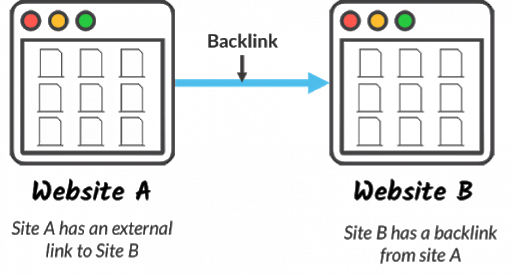
Source: Moz
But you can’t just build any backlinks and expect your rankings to soar.
The fact is, not all backlinks help your site.
Low-quality links pointing to your website can actually hurt your rankings and trigger a penalty from search engines.
Good backlinks are:
- Quality. Aim for backlinks from authoritative sites that people trust and respect. Look for sites that have a high domain authority score (out of 100).
- Relevant. Aim for backlinks that are related to your site and make sense. Use anchor text (visible, clickable text of a link) to tell the user what to expect if they click on the link.
- Natural. Do not buy links. Google looks for how many backlinks you’re getting over time. You need to earn it.
To track your backlinks, use tools like Google Search Console and Moz:
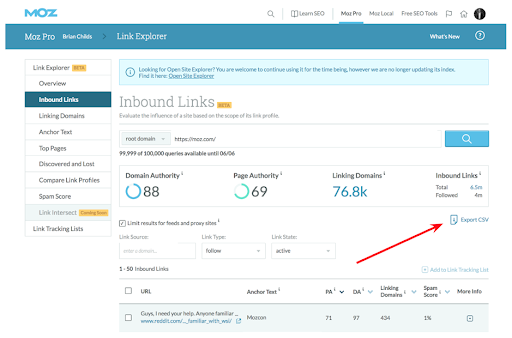
Source: Moz
Mistake 6. You don’t audit your website
How do you know if your site is getting indexed and ranked?
There could be a hundred little things wrong with your site that are stopping it from ranking as it should be.
The only way to find out is to audit your site on a regular basis and fix any errors.
This could be things like:
- Broken links
- Duplicate content
- URL parameter errors
- Slow site speed
- Missing meta tags
There are a few tools you can use to audit your site.
The first tool is Ahrefs Site Audit:

Source: Ahrefs
Another one is Google Search Console.
Go into Search Console to see the Crawl Stats.
The crawl rate tells you how fast and search-bot friendly your site is. Track this over time to see how your site is performing:
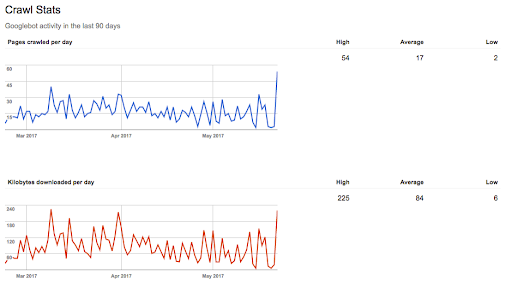
Mistake 7. Your content is far from awesome
Ever come across a site that has poor content?
Of course you have.
What happened next? Did you stick around to find out more and buy the product?
Not likely!
Chances are you did what most people do – you left the site faster than we can say “bad SEO”.
Poor content is one of the biggest digital marketing fails.
Yet many site owners don’t realise the impact it can have on SEO.
Fact: SEO and content go hand in hand.
To get in front of people who are searching for what you have to offer, you must combine your content marketing with your SEO efforts.
The more useful and relevant your content, the higher your site will rank in the SERPs.
The reverse is true too – poor content turns users away from your site and sends warning signs to search engines that your site is not relevant to users.
The result?
Google ranks your pages lower.
Here’s how to create killer content:
A. Know your target audience
Great content starts with knowing your ideal customer. Create buyer personas to find out exactly who your customers are and what they want – this helps you answer their needs using your content.
B. Create targeted content for each stage of the buyer’s journey
Target your content for each stage of the journey: awareness, consideration, decision, retention and advocacy. This ensures your content is returned in the SERPs whether people are just starting to look or ready to buy.
C. Create long-form content
Research shows long-form content (between 3000 -10,000 words) gets an average of 77.2% more links than shorter content.
Remember, Google looks at your link profile when ranking your web pages. So if you are earning quality backlinks from your long-form content, you’re onto a winner.
Another reason long-form content performs well in search rankings?
Visitors spend longer on your site reading it – and Google factors “time spent” into its ranking algorithm.
D. Make your content useful
Publishing “thin” content doesn’t provide any real value to your target audience. Your headline might get them onto your site, but if they don’t find any value when they get there, they won’t stick around or come back.
Need help with your content?
Start by using a tool like Buzzsumo.
This tool is popular with content marketers as it helps you search for keywords to see who’s writing about what in your area, and how people are engaging with that content.
There’s also a handy Content Analysis feature which helps you discover the types of content that work best in your niche (e.g. video, blog post, infographic etc.)
Mistake 8. Your site is not mobile friendly
If you only need one reason to invest in a mobile friendly website, this is it:
60% of Google searches are done using mobile devices (Statista)
If you want to get in front of people exactly when they need your products and services, you need to show up in their mobile search.
Google has made this non-negotiable for site owners.
One of Google’s most impactful algorithm updates is the Mobile-Friendly Update of 2015, AKA “Mobilegeddon”.
Since that update, Google has rewarded mobile-friendly websites in search rankings and lowered visibility for non-responsive websites.
Then, Google launched its Mobile First Index.
This means it crawls and indexes web pages based ONLY on the mobile version of a page – not the desktop version.
The good news?
Optimising your website for mobile is not as difficult as you might think.
Follow this checklist:
A. Give users an easy, seamless experience visiting your site on mobile.
Use the Mobile Friendly Test on the Google Search Console to check if your site has any issues.
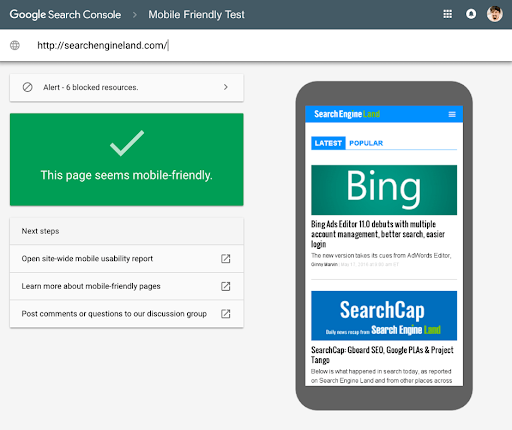
If your site doesn’t pass, Google tells you why so it’s easy to fix.
B. Speed up your site
How fast does your site load? Google recommends for sites to load in under one second for mobile.
Check how your load speed on Google’s PageSpeed Insights tool. Again, it provides tips on how to speed things up if needed.
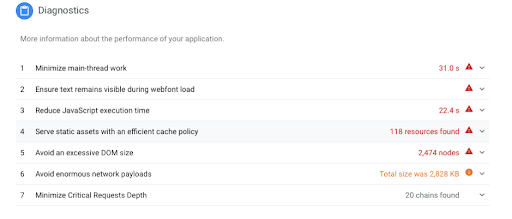
C. Make content easy to access and read on mobile
This is all about creating a brilliant user experience.
Here are some easy tips:
- Make fonts big and readable, at least 16pt font
- Break up text into paragraphs of just a couple of sentences
- Use contrast between text and background
Mistake 9. Your internal link structure is shoddy
Here’s the problem – as your website grows in size with all that great content you’re
creating, unless you’re careful, its internal link structure will soon end up in disarray.
We’re talking about broken links, pages that link to nowhere, duplicate content, and a structure that makes no sense.
Many site owners neglect their internal link structure because they simply don’t realise how important it is.
Internal links have a very important job to do. They connect pages within your site to create clear crawling paths for search bots and an easy navigational path for your users.
A solid internal link structure has clear benefits:
- Helps Google understand your site architecture for indexing.
- Keeps users on your site for longer, which helps Google rank you higher.
- Improves the value of your content.
Using your internal link structure, you can give the most important content more link value (aka “link juice”) than other pages.
The more links you give a page, the more “link juice” it has:
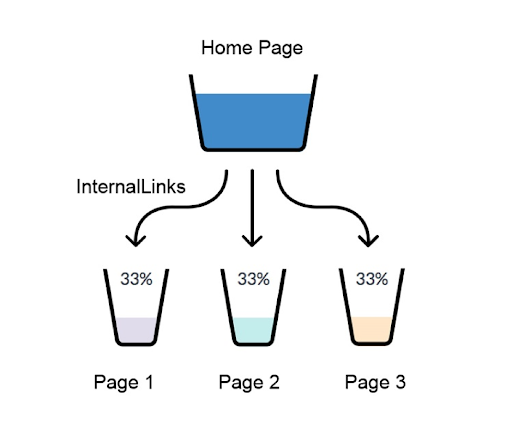
Source: Search Engine Journal
Here’s what you can do:
- Make links relevant. Find clusters of pages focused on particular topic and link between them.
- Delve deep into your site structure. Main navigational pages, like Contact Us and Home, tend to have lots of internal links already. So, delve deeper into your site to other pages and blogs – so long as they are relevant.
- Make links natural. Never link for the sake of linking. Internal linking should always add value for the reader, whether that’s expanding on a topic or providing other helpful resources.
- Audit old content. Do your older posts have enough internal links? Audit your content using a tool like SEMrush Site Audit. Look for opportunities to add link juice to valuable pages.
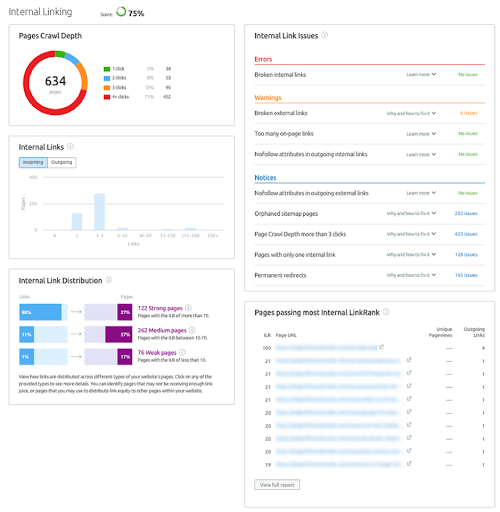
Source: SEMrush
Mistake 10. User Experience is not your #1 priority
By now, you might have noticed a theme running through these mistakes.
User experience.
If you do not put user experience first, you will never succeed in your SEO efforts.
Harsh, but true.
Google wants you to put your users first.
Whether it’s your site structure, content, social media or link building, everything you do with SEO should be for the users first.
Over recent years, that’s what Google’s updates have been focusing on.
The search engine’s algorithms are designed to reward sites that provide a seamless and valuable user experience.
And it’s not just Google that looks for a great user experience (UX).
A massive 88% of users are unlikely to return to a website after one bad experience.
This goes all the way to your bottom line – companies with highly effective UX have increased their revenue by 37%, according to UXpassion.
Follow the tips above and you will create a user experience that will not only get your ranking higher, you’ll see revenue-smashing results over the long term.
Want to avoid SEO mistakes and see sustainable revenue results from your strategy?
Get your free Ultimate Guide To SEO and learn all the tried and true secrets from world-class SEO consultants and marketing minds alike.









